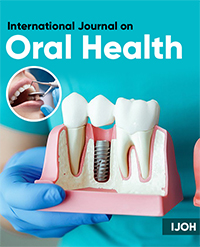Tooth Decay and Periodontal Disease Epidemics that can be Prevented
Michelle Morón Araújo*
Dentist, Pontificia Universidad Javeriana, Colombia
*Corresponding author: Michelle Morón Araújo, Dentist, Pontificia Universidad Javeriana, Periodontist, Pontificia Universidad Católica, Transv 19ª #97-59 Bogotá, Colombia
Article History
Received: February 13, 2021 Accepted: February 18, 2021 Published: February 19, 2021
Citation: Araújo MM. Tooth Decay and Periodontal Disease Epidemics that can be Prevented. Int. J. Orl. Health. 2021;1(1):01‒02. DOI: 10.51626/ijoh.2021.01.00001
Abstract
Dental caries and periodontal disease are epidemics that have spread worldwide due to inadequate oral hygiene, excessive consumption of sugar, lack of oral health programs. Oral health education and prevention promotion programs are important to combat this epidemic. Proper oral hygiene at home and control of sugars.
Keywords: Dental caries, Periodontal disease, Education, Promotion, Oral health
Introduction
The word epidemic is defined when a disease that is actively spreading due to the outbreak getting out of control and continuing over time. In this way, the number of cases in a specific geographical area increases.
At the end of 2019 and the beginning of 2020, a pandemic originated from the outbreak of the new coronavirus SARS-CoV2 (Severe acute respiratory syndrome coronavirus), identified as the etiological agent of the 2019 coronavirus disease (COVID-19) called one of the Pandemics of the 21st century have become a potential health emergency affecting every country in the world [1].
The WHO (World Health Organization) describes that 90% of the world population have or have had oral diseases such as dental caries and periodontal disease and 60 and 90% affect the school population, the Netherlands and, increasingly often in developing countries, especially among the poorest communities, this represents a public health problem and challenges for health ministries and institutions [1].
This short communication describes and analyzes the epidemic of cavities and periodontal disease as a public health problem, which can be used by community oral health programs to prevent it. Oral diseases, share a wide range of risk factors such as age, sex, and hereditary conditions, are intrinsic to the person and cannot be changed or modified. Others, which are subject to behaviors and lifestyles, are considered modifiable risk factors, since individual action and modification of a particular habit or behavior is possible [2].
Dental caries is a multifactorial disease that develops due to the relationship between the dental surface and the bacterial biofilm of dental plaque, the presence of sugars in the daily diet and incorrect oral hygiene. Periodontal disease begins with gingivitis when there is inflammation and bleeding in the gums, if this remains for a long time and is not controlled, periodontitis develops as an infectious pathology that entails or leads to the destruction of dental support structures such as: the periodontal ligament, the alveolar bone and the root cement [2].
15% of the world population have periodontal disease, which can end with tooth loss. Populations with ages between 65-74 years, around 30% of the population have lost all their teeth, periodontal diseases being the main cause. Smoking and poor oral hygiene are one of its main causes [3].
Dental caries and periodontal disease in addition to presenting a problem in oral health, they also present a significant relationship in general disease such as diabetes, cardiovascular diseases, oral cancer, among others [3].
Oral diseases affect 3.9 billion people worldwide, with untreated dental caries being the most prevalent, and severe periodontitis the sixth, of 291 diseases studied. Its impact on the well-being and quality of life of people and societies is evident in all stages of life. Evidence from different countries demonstrates considerable absenteeism from school and work related to oral conditions [4].
There is no vaccine to prevent tooth decay and periodontal disease. To prevent and control this epidemic, it is important that each country establishes and knows the common risk factors such as excessive consumption of sugar, tobacco, alcohol, poor diet, inadequate oral hygiene, and establish oral health programs especially in children and vulnerable populations. Parents should take care of the oral health of their children by controlling tooth brushing at home and controlling the consumption of sugars [5].
Verify oral health systems and policies, giving priority to Dentists and comprehensive primary health teams. The dentist must be taken into account within the integral medical team and work as a team to prevent, control and treat that these diseases continue to spread worldwide.
Conclusion
Oral health is part of general health. Some general diseases have manifestations in the mouth and diseases of the mouth cause alteration in the general state of people. The main diseases of the oral cavity are dental caries and periodontal disease. In health services, the dental consultation is within the first 10. There are methods and programs to prevent and diagnose early dental caries and this epidemic does not continue to spread and affect the entire population, especially children and adolescents.
References
- OPS/OMS (2020) La OMS caracteriza a CO-VID-19 como una pandemia.
- Duque C, Mora II (2012) La representación de la epidemiología de la caries en el mundo a través de mapas. Univ Odontol 31(66): 41-50.
- Nithila A, Bourgeois D, Barmes DE, Murtomaa YH (1998) Banco Mundial de Datos sobre Salud Bucodental de la OMS, 1986-1996: panorámica de las encuestas de salud bucodental a los 12 años de edad. Rev Panam Salud Pública/Pan Am J Public Health 4(6): 411-418.
- Petersen P (2003) The World Oral Health Report 2003: continuous improvement of oral health in the 21st century—the approach of the WHO Global Oral Health Programme. Community Dent Oral Epidemiol (Suppl 1): 3-23.
- (1994) Boca sana-vida sana: enfermedades bucodentales. Es mejor prevenir que curar. En: Documento de la Unidad de Salud Bucodental, 1994. Referencia DMS94.2. Washington DC, USA.

